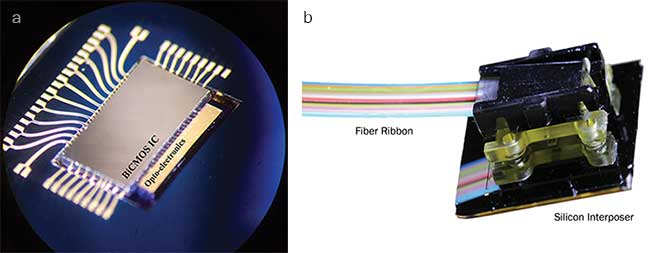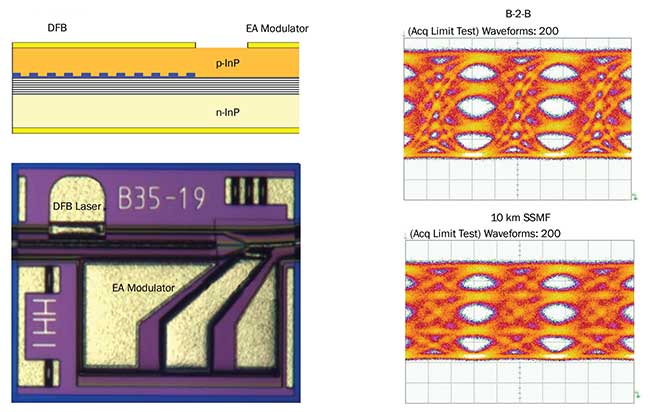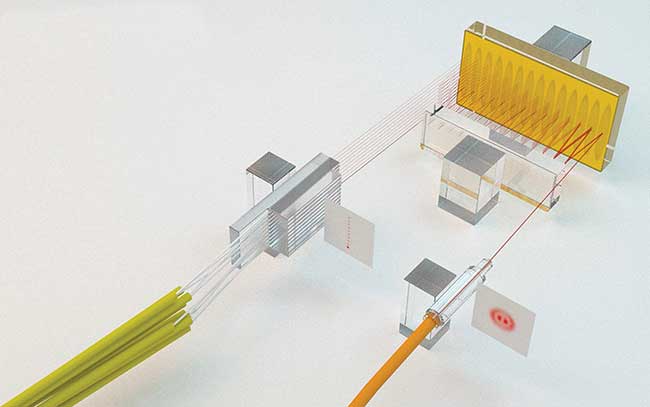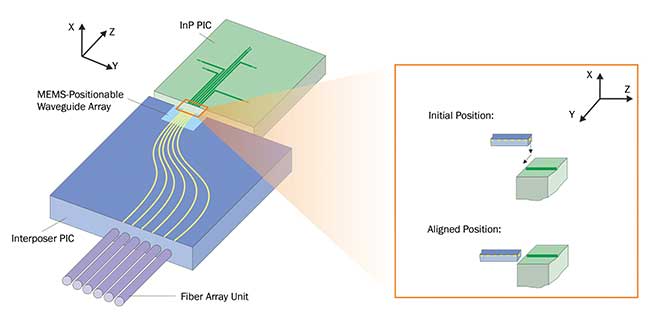ANA BELÉN GONZÁLEZ GUERRERO AND JOSE POZO, EUROPEAN PHOTONICS INDUSTRY CONSORTIUM
In the communications sector, short-distance connections, as required in a data center, benefit greatly from optical fibers. But what is best, single-mode or multimode communication?
There has been recent progress in the application of photonics technologies in the datacom field, including discrete components (PICs, VCSELs, LEDs), modules and systems (transceivers, receivers), fibers and connectors (types, deployment costs, alignment requirements), and new architectures for transport networks.
The growing number of users, amount of content being exchanged, and services such as cloud computing and mobile smartphones exponentially increase the traffic demand in data centers. This all requires bandwidths that only fiber optics can provide. Fortunately, the cost of fiber optics is already competitive with copper wires. Furthermore, the processing and testing techniques required to integrate these fibers into functional systems are already mature because of the efforts of companies such as Arden Photonics, OpTek Systems, Sylex, and VPIphotonics.
Multimode vs. single-mode fiber
Multimode fiber optic cables have a large diametral core that allows multiple modes of light to propagate, creating the ability for more data to pass through at a given time. The 850-nm wavelength was established long ago for multimode fiber (MMF) transmission. However, chromatic dispersion limits the distance capability of multimode systems to around 100 m.

Figure 1. Companies such as PhotonX Networks are working on commercializing innovative low-cost packaging concepts for VCSEL-based interconnects coming from the Eindhoven University of Technology. PhotonX develops packaging concepts based on VCSEL solutions using both 2.5D (a) and 3D (b) integration for the electrical connection. Courtesy of PhotonX Networks/Eindhoven University of Technology.
MMF dominates the short-reach optical interconnects in data centers using 850-nm vertical-cavity surface-emitting lasers (VCSELs), reaching up to 100 m at high data rates (i.e., 25 to 28 Gb/s on-off keying [OOK] and 50 to 56 Gb/s PAM4) when employing OM4 MMF. For example, OFS Optics’ existing technology already includes the last standardized OM5 fiber, supporting 100-Gb/s transmission over a single fiber — in addition to a duplex link (transmit/receive) over a pair of fibers — using wavelength division multiplexing (WDM). This is the first multimode fiber developed to support transmission at multiple wavelengths. PhotonX Networks develops low-cost packaging concepts based on VCSEL solutions using both 2.5D (Figure 1a) and 3D (Figure 1b) integration for the electrical connection.
Single-mode systems need coherent sources such as laser diodes, making them more expensive and requiring more precise calibration than LEDs used for multimode fiber systems.
In single-mode fiber optic cables, the diametral core is small (8 to 10 µm), allowing only one mode of the light to propagate. So the number of light reflections created decreases as the light passes through the core, which lowers attenuation and allows the signal to travel farther. Single-mode fibers (SMF) are typically used for long distances and with higher bandwidth. However, single-mode systems need coherent sources, such as laser diodes, which make them more expensive and require more precise calibration than the LEDs used for MMFs. Also, because of the reduced dimension of the core, single-mode systems are more sensitive to the dust. Table 1 compares multimode and single-mode systems, showing the relative transceiver cost, relative power consumption, relative dust sensitivity, and IEEE-supported link length.

Table 1. Comparison of multimode and single-mode systems. Values for cost and power are relative to 10-G multimode transceivers. Values for dust sensitivity are relative to 50-µm multimode fiber. Courtesy of Corning Inc.
Also, few-mode transmission (FMT) enables the transmission of multiple signals over the same wavelength by exploiting different transmission modes. Alternatively, multicore fibers include an array of physically separated, single-mode cores within the same cladding, avoiding crosstalking between modes. There is thus a need to increase the range of MMF to reach greater distances at higher bandwidths or reduce the cost of the optical components required to implement SMFs into data centers.
A solution proposed by Corning Inc. now consists of an MMF with 300-m support at 25 G; in the future this will be 50 and 100 G, based on non-return-to-zero (NRZ) optical lanes. To achieve the 300-m/100-G target, it must move closer to the zero-dispersion wavelength of 1310 nm. The performance of this system has already been demonstrated in different studies, such as one published by Larson and colleagues from Chalmers University1 using a prototype MMF fabricated at Corning and a 1060-nm VCSEL.
To reduce the cost of the components, such as sources required for SMF, different options are under development. The Fraunhofer Heinrich-Hertz-Institut develops externally modulated lasers (EML) based on indium phosphide (InP) distributed-feedback (DFB) laser diodes in various shapes — standard EML, tunable EML, EML for array chips, impedance-matched EML, and EML with integrated SOA (semiconductor optical amplifier). This very simple EML makes possible PAM4 (pulse amplitude modulation) at 28 GB; no significant signal degradation after 10 km can be seen in Figure 2. Furthermore, 56-G or 100-G NRZ modulation is possible.

Figure 2. Externally modulated lasers (EMLs) achieving PAM4 at 28-Gbaud transmission (100-mM DFB, 40-G photodiode), observing no significant signal degradation after 10 km. Courtesy of Fraunhofer Heinrich-Hertz-Institut. DFB: distributed feedback laser; EA: electroabsorption; B-2-B: back to back; SSMF: standard single-mode fiber.
Rennes, France-based CAILabs’ multiplane light conversion system has introduced patented technology that allows single-mode transmission performance over multimode fibers through spatial mode control (Figure 3). With this technology, it is possible to reach mode-division multiplexing, where the spatial modes are used as independent data channels.
Integrated photonics
The smaller the device, the less power required. The use of miniaturized chips containing photonic integrated circuits (PICs) in telecommunications will increase in the coming years because of the need to reduce energy consumption and costs.

Figure 3. Multiplane light conversion-spatial mode multiplexing and beam shaping. It can transform the spatial shape (mode) of a coherent input beam to any desired output shape with full phase control and very limited losses. Furthermore, multiple input beams can be transformed simultaneously into any desired set of orthogonal output modes without increased losses. Courtesy of CAILabs.
InP is playing a crucial role in the development of laser technology and transceivers. For research and technology development, InP multiproject wafers (MPWs) are offered at very competitive rates for different foundries, including the one at SMART Photonics.
Also, silicon photonics platforms allow the development of ultralow-power and small-size 100-Gb/s transceivers (from AIO Core) and NRZ systems for on-board and board-to-board links (as with the European project TERABOARD).
One of the challenges in the incorporation of PICs in datacom components is how to couple the light in such small structures.
Eindhoven University of Technology (TU/e) is developing systems based on InP integrated photonics that focus on single-mode, multimode, and multicore connectivity. These will allow for the relaxing of alignment tolerances, resulting in robustness in front of the temperature variation. Via a technique based on MEMS-assisted fiber-chip coupling, it is possible to use microelectromechanical systems that actuate the silicon oxidenitride optical waveguide to provide the required submicron alignment accuracy of the laser with PICs. It uses an intermediate TriPleX interposer (provided by LioniX International), with waveguides that match the size of the waveguide mode of the PIC on one side and that of a standard SMF at the other side (Figure 4).

Figure 4. Microelectromechanical systems using an interposer photonic integrated circuit (PIC) based on TriPleX technology. It allows the placement on carrier with an accuracy of 2 µm. Courtesy of Eindhoven University of Technology.
Until now, the high cost of packaging and assembly of PICs has been a bottleneck for the implementation of integrated optics as optical links for intraboard and board-to-board applications. For that, PIXAPP, the first pilot line for packaging PICs, was launched in 2017 by the Photonics Public Private Partnership to reduce the costs of high-volume manufacturing by the development of standards and the automation of processes.
Others, such as INPHOTEC, OptoCad, and Yelo, offer prototyping and production of high-added-value components and circuits for datacom to academia and industrial SMEs. They also offer services related to prototype and pilot assembly, automated volume manufacturing, and testing process development.
Transport networks
CommScope has developed a new concept for fiber network convergence — one build-out that could be used for multiple service delivery platforms. For example, fiber-to-the-home (FTTH) networks have an extensive footprint that is well-suited for supporting fast-growing mobile applications, such as distributed antenna systems (DASs), small cell and Wi-Fi backhaul, and/or centralized-RAN (radio access network) fronthaul.
PASSION — a Research and Innovation Actions project funded by the EU’s HORIZON 2020 — has adopted a disruptive approach to developing innovative photonic devices and an optical fiber network infrastructure for sustainable metropolitan networks in terms of huge capacity, low cost, reduced footprint, and low power consumption. PASSION technology exploits the capabilities of VCSELs by developing 25-GHz-spaced InP C-band WDM single-mode VCSELs directly modulated to achieve up to 50 Gb/s per SOP (state of polarization). Multiple single-mode VCSEL modules on silicon-on-insulator (SOI) chips adaptively load/manipulate the spectrum at the subwavelength level to generate flows aggregated to enable up to 16 Tb/s capacity per channel.
Europe has a strong photonic ecosystem that is pushing the development of innovative solutions for both single-mode and multimode communications. The region is expected to play an important role in the next evolution of the telecommunications field, in which copper systems will be replaced by fiber systems, even inside data centers, to satisfy the increasing demand for bandwidth.
Meet the authors
Ana Belén González Guerrero, Ph.D., is a project leader at the European Photonics Industry Consortium (EPIC). Her expertise lies in the development of systems based on integrated photonic circuits, packaging and assembly, and the investigation of applications such as chemical/biological sensing and datacom. In addition, she has been involved in technology transfer and business development processes. She has a bachelor’s degree in chemistry from the University Autonomous of Barcelona and a doctorate from the Catalan Institute of Nanoscience and Nanotechnology.
Jose Pozo, Ph.D., is the director of technology and innovation at EPIC. He has 15 years’ background in photonics technology and market knowledge, and he has a large network within the industrial and academic photonics landscape. Pozo is a member of the board of the IEEE Photonics Society Benelux. He has a doctorate in electrical engineering from the University of Bristol in England and bachelor’s and master’s degrees in telecom engineering.
Acknowledgments
We have offered in this article a summary of the technical advances presented at the EPIC meeting, Single-Mode vs. Multimode Communication, held in June 2018 at CommScope in Kessel-Lo, Belgium.
EPIC wishes to thank its members, in particular, AIO Core, Arden Photonics, CAILabs, CEA-Leti, Chalmers University, CommScope, Corning Inc., Diamond Kimberlit, fibeReality, ficonTEC, Fraunhofer Heinrich-Hertz-Institut, Fraunhofer IZM, imec, Ghent University, Innolume GmbH, Multiphoton Optics, OFS Optics, OpTek Systems, Optoelectronics Research Centre, PhotonDelta, Photonic Integration Technology Center, PhotonX Networks, Politecnico di Milano, Prysmian Group, Resolute Photonics, SABIC, Samtec, Skylane Optics, SMART Photonics, Sylex, University of Technology Eindhoven/Institute for Photonics Integration, US Conec, VPIphotonics, Vrije Universiteit Brussel, and Xeryon.
Reference
1. Larson et al. (2018). 1060-nm VCSELs for long-reach optical interconnects. Optical Fiber Technology, Vol. 44, pp. 36-42. doi:10.1016/j.yofte.2018.01.001.